Judge: Ban on police recruits' tattoos 'discriminatory, ill-advised'

A High Court judge has deemed a police policy on recruits with tattoos “discriminatory and ill-advised.”
Justice Frank Seepersad found: “There is an evident dichotomy and inequality of treatment with respect to potential recruits and serving officers in relation to visible tattoos and there is no apparent justification for a blanket prohibition against visible tattoos.”
He also said the police should focus on more important things, especially given the state of crime.
On Tuesday, he declared the rights of a Debe graphic artist were violated by the “unconstitutional and illegal” policy.
Seepersad has ordered compensation for Dillon Ramraj, of Cuchawan Trace, Debe, who was told he could not apply to become a police officer because of a Shuriken (ninja star) tattoo on his left hand.
Ramraj challenged the constitutionality of the service’s body-art policy.
In his ruling, Seepersad said the State failed to point to any logical basis for the policy for recruits.
“There must be a rational and reasonable connection between the tattoo policy and the restriction imposed upon the rights of the individual but based upon the information placed before this court, it is difficult to comprehend why the visibility of a tattoo serves to disqualify a citizen who wishes to protect and serve.”
The judge said Ramraj’s tattoo, though visible, was innocuous.
“The tattoo policy, in its current form, stands as an archaic, artificial administrative barrier which occasions significant prejudice. Its existence and implementation are unreasonable and cannot be justified in a modern democratic state.
“In a society, such as this, where citizens clamour in fear because they are under siege and plagued by rampant criminal conduct, it is difficult to comprehend why the recruitment process is concerned about the visibility of tattoos and its attention is not focused upon the character, integrity and ability of potential recruits.”
The judge pointed to Monday’s budget announcement of a trebling of recruits for the police service in 2024 and said “pointless recruitment obstacles” should be a priority.
“Now, more than ever, a full complement of competent and capable police officers is required and an ‘all hands on deck' approach is absolutely needed.”
He also said the policy was arbitrary and unreasonable in that it only applied to recruits, so the requirement for recruits' tattoos to be covered or camouflaged seemed "pernicious, puerile and pointless.”
Seepersad said tattoos are relatively permanent markings and the process of removing one is painful, so there was a burden on the State to establish that the service’s body art policy had a legitimate aim or that its reputation or an officer’s ability to do his duty would be hampered by a visible tattoo at the recruitment stage.
“It is not lost upon the court that once they are recruited, police officers are free to proudly display tattoos,” the judge said as he referred to ASP Roger Alexander, the co-host of the police’s Beyond the Tape programme, whose arm tattoos extend beyond his cuffs and are plainly visible.
“It is odd that no issue is taken with respect to the visibility of tattoos on a senior and respected officer who is a representative for the TTPS on a national level, via prime-time television, but the issue is taken with the recruitment of an individual, like the claimant, whose tattoo was seen only by the TTPS’s recruiting personnel and not the public at large.”
Seepersad said a visible tattoo which was not offensive could not logically affect a police officer’s ability on the job, nor was there evidence of a connection between the policy and the curation of a competent and capable workforce.
“Restrictive, arbitrary and ill-advised policies," he said, could also deter applicants and limit the pool of possible recruits .
“Tattoos and body art are a form of expression and democratic societies should adopt a cautious approach when dealing with the curtailment of an individual’s right to express oneself by having any form of body art."
He said many people now had a “a liberal and all-inclusive sense of acceptance and fluidity", especially about behaviour, appearance and inter-personal interaction.
“The norms of the past are not necessarily accepted as the norms of the present.
“Laws are meant to govern and regulate a society and respect for the rule of law is only engendered when constitutional standards and the law are regarded by the majority as being relevant and relatable.”
Seepersad said for many, matters which affect appearance, including makeup, hairstyles, jewellery or body art, were forms of expression intimately connected to their sense of identity.
“Within the context of the police service, as long as these personal forms of expression and issues of appearance do not violate prevailing societal standards of decency, convey positions premised upon hatred, division or discord, impede or restrict the individual’s ability to perform assigned duties, offend operative religious and cultural norms, convey an impression of bias, bigotry and/or unprofessionalism or suggests that there is a propensity to be corrupt and/or dishonest, there can be no justification for policies which prohibited them.”
He also said in Ramraj's case, he did all he could to remove his tattoo, but was unsuccessful.
Ramraj was represented by Anand Ramlogan, SC, Renuka Rambhajan, Jayanti Lutchmedial, Dr Che Dindial, Natasha Bisram and Ganesh Saroop.
Coreen Findley and Nisa Simmons represented the Attorney General.


Comments
"Judge: Ban on police recruits’ tattoos ‘discriminatory, ill-advised’"